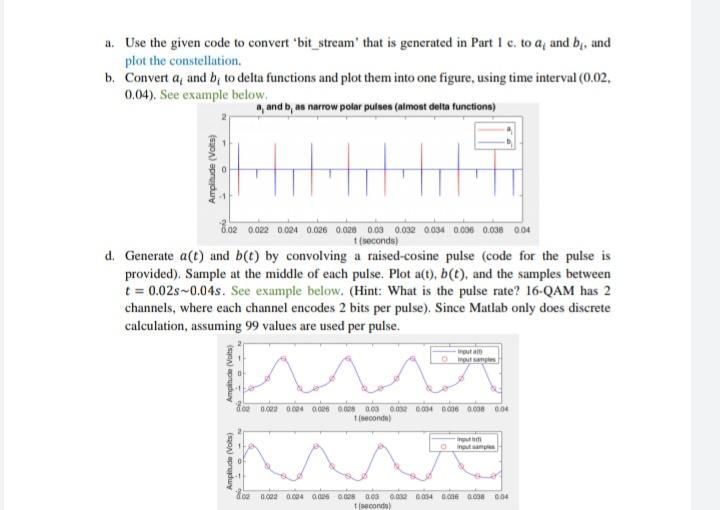Answered step by step
Verified Expert Solution
Question
1 Approved Answer
a. Use the given code to convert 'bit_stream' that is generated in Part I c. to a, and by, and plot the constellation. b.

a. Use the given code to convert 'bit_stream' that is generated in Part I c. to a, and by, and plot the constellation. b. Convert a, and b, to delta functions and plot them into one figure, using time interval (0.02. 0.04). See example below. a, and b, as narrow polar pulses (almost delta functions) Amplitude (Volts) 8.02 0.022 0.024 0.025 0.028 0.03 0.032 0.034 0.036 0.036 0.04 t(seconds) d. Generate a(t) and b(t) by convolving a raised-cosine pulse (code for the pulse is provided). Sample at the middle of each pulse. Plot a(t), b(t), and the samples between t = 0.02s~0.04s. See example below. (Hint: What is the pulse rate? 16-QAM has 2 channels, where each channel encodes 2 bits per pulse). Since Matlab only does discrete calculation, assuming 99 values are used per pulse. Amplitude (Volts) Amplitude (Volts) Input att Oput samples AX 602 0.002 0.024 0.026 0.028 0.03 0032 0.034 0006 0.008 0.04 1(seconde) 0 Input samples 02 0.002 0.024 0.025 0.025 0.00 0.002 0.034 0.00 0.008 0:04 (seconds)
Step by Step Solution
★★★★★
3.33 Rating (153 Votes )
There are 3 Steps involved in it
Step: 1
a To convert the bitstream into a and b and plot the constellation you can use the provided code Bel...
Get Instant Access to Expert-Tailored Solutions
See step-by-step solutions with expert insights and AI powered tools for academic success
Step: 2

Step: 3

Ace Your Homework with AI
Get the answers you need in no time with our AI-driven, step-by-step assistance
Get Started


